Discrete Mathematics: Probability & Lottery Game Analysis Report
VerifiedAdded on 2023/04/21
|17
|2468
|306
Report
AI Summary
This report explores the application of discrete mathematics in analyzing lottery games, focusing on probability and the challenges of manual lottery systems. It addresses issues such as game fixing, rigging, and human error in manual lottery processes. The report proposes a computerized lottery system utilizing permutation and combination algorithms to enhance transparency, accuracy, and efficiency. It details the specification of the utilized algorithm and provides a comprehensive example. The conclusion highlights the benefits of computerized lottery systems in improving work efficiency and accuracy while emphasizing the importance of proper implementation to avoid potential errors. Desklib offers students access to this and other solved assignments.
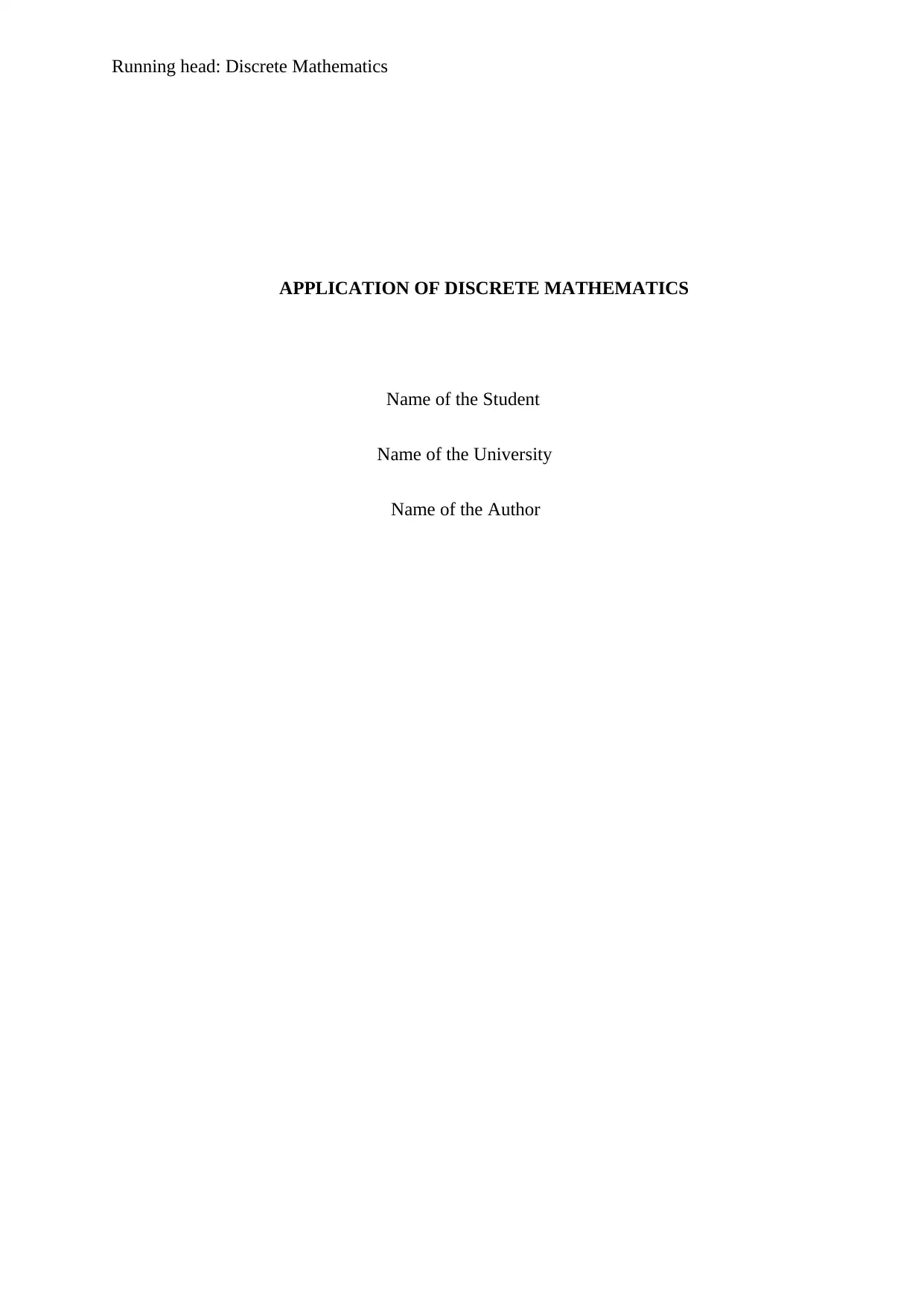
Running head: Discrete Mathematics
APPLICATION OF DISCRETE MATHEMATICS
Name of the Student
Name of the University
Name of the Author
APPLICATION OF DISCRETE MATHEMATICS
Name of the Student
Name of the University
Name of the Author
Secure Best Marks with AI Grader
Need help grading? Try our AI Grader for instant feedback on your assignments.
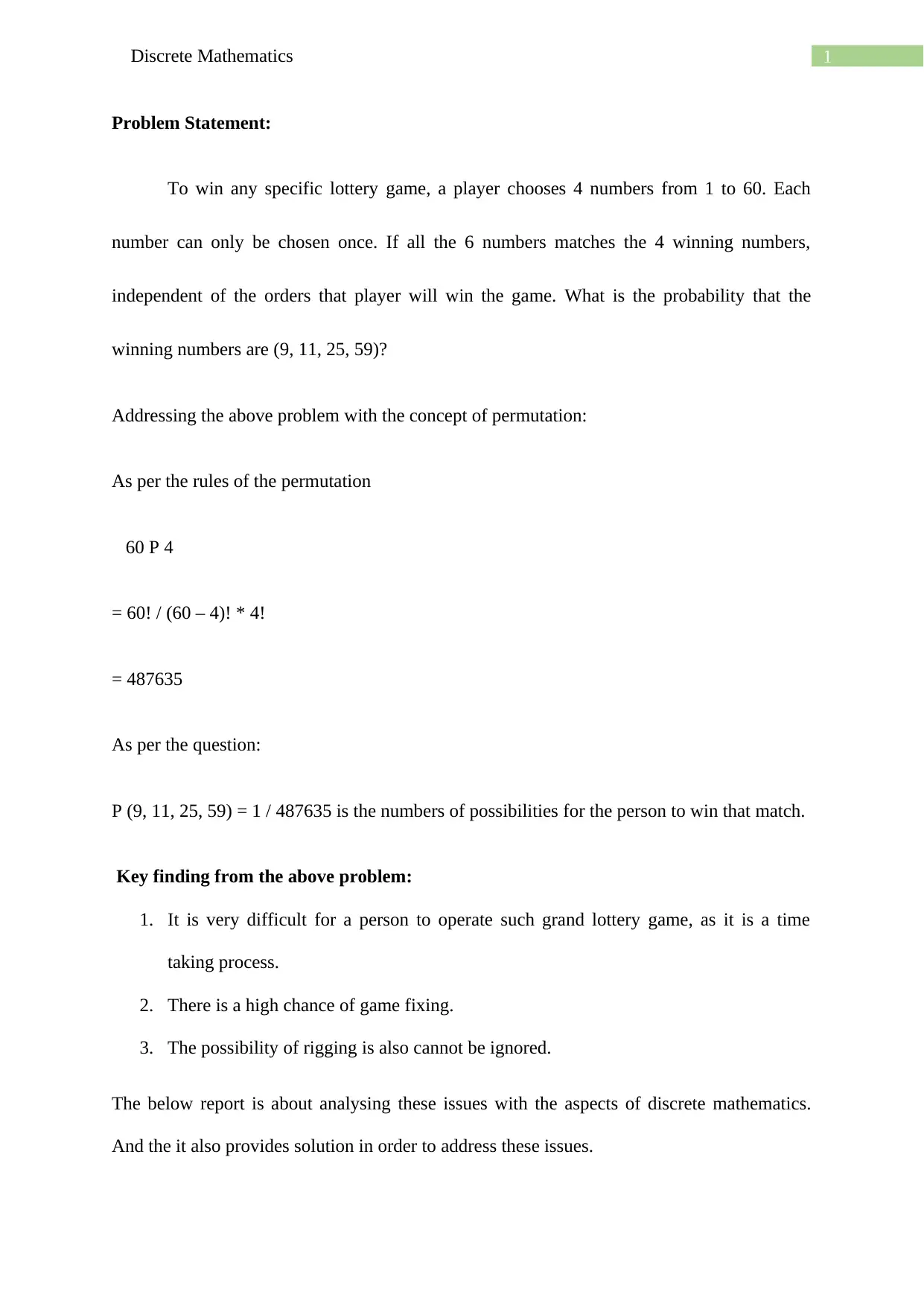
1Discrete Mathematics
Problem Statement:
To win any specific lottery game, a player chooses 4 numbers from 1 to 60. Each
number can only be chosen once. If all the 6 numbers matches the 4 winning numbers,
independent of the orders that player will win the game. What is the probability that the
winning numbers are (9, 11, 25, 59)?
Addressing the above problem with the concept of permutation:
As per the rules of the permutation
60 P 4
= 60! / (60 – 4)! * 4!
= 487635
As per the question:
P (9, 11, 25, 59) = 1 / 487635 is the numbers of possibilities for the person to win that match.
Key finding from the above problem:
1. It is very difficult for a person to operate such grand lottery game, as it is a time
taking process.
2. There is a high chance of game fixing.
3. The possibility of rigging is also cannot be ignored.
The below report is about analysing these issues with the aspects of discrete mathematics.
And the it also provides solution in order to address these issues.
Problem Statement:
To win any specific lottery game, a player chooses 4 numbers from 1 to 60. Each
number can only be chosen once. If all the 6 numbers matches the 4 winning numbers,
independent of the orders that player will win the game. What is the probability that the
winning numbers are (9, 11, 25, 59)?
Addressing the above problem with the concept of permutation:
As per the rules of the permutation
60 P 4
= 60! / (60 – 4)! * 4!
= 487635
As per the question:
P (9, 11, 25, 59) = 1 / 487635 is the numbers of possibilities for the person to win that match.
Key finding from the above problem:
1. It is very difficult for a person to operate such grand lottery game, as it is a time
taking process.
2. There is a high chance of game fixing.
3. The possibility of rigging is also cannot be ignored.
The below report is about analysing these issues with the aspects of discrete mathematics.
And the it also provides solution in order to address these issues.

2Discrete Mathematics
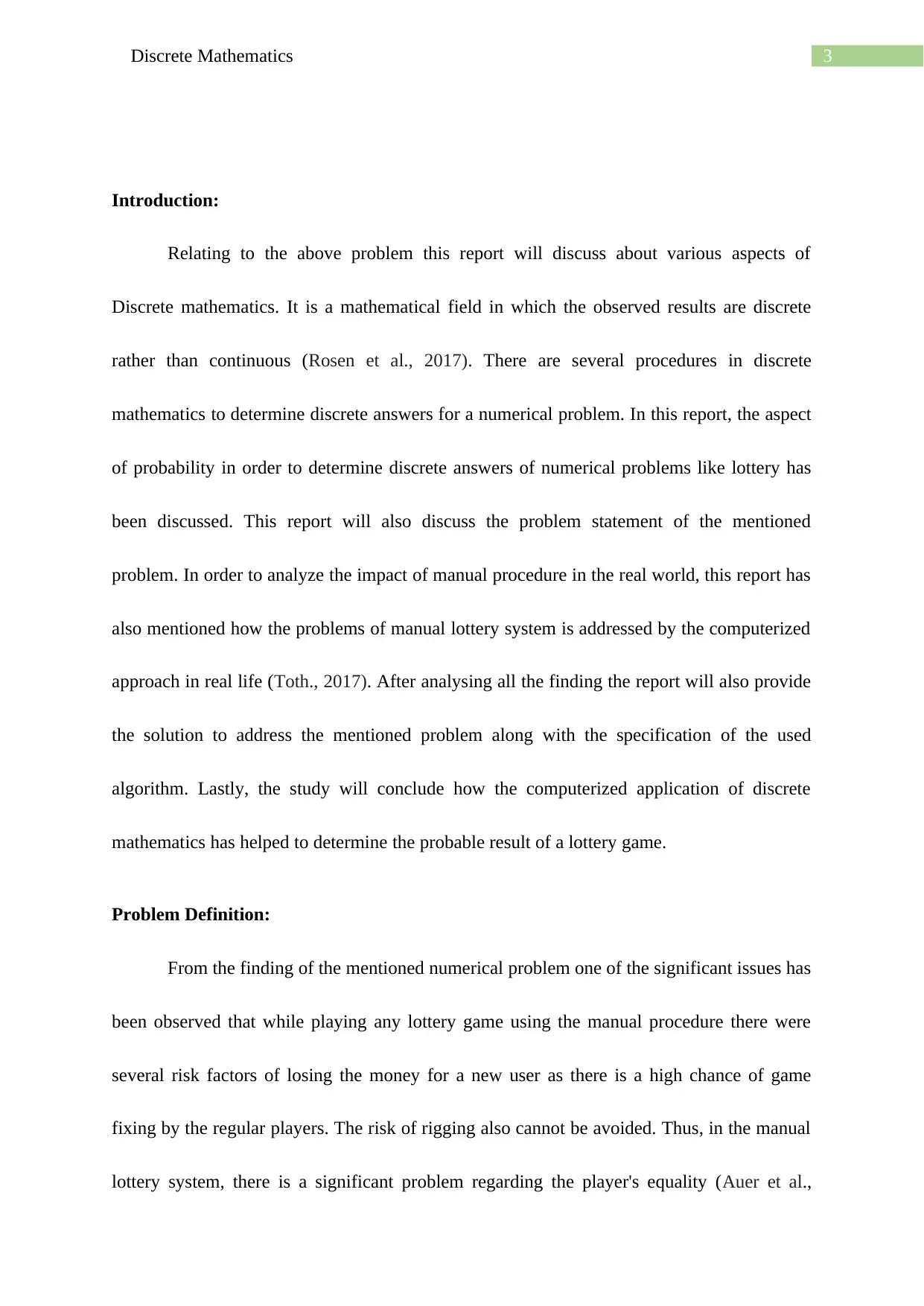
3Discrete Mathematics
Introduction:
Relating to the above problem this report will discuss about various aspects of
Discrete mathematics. It is a mathematical field in which the observed results are discrete
rather than continuous (Rosen et al., 2017). There are several procedures in discrete
mathematics to determine discrete answers for a numerical problem. In this report, the aspect
of probability in order to determine discrete answers of numerical problems like lottery has
been discussed. This report will also discuss the problem statement of the mentioned
problem. In order to analyze the impact of manual procedure in the real world, this report has
also mentioned how the problems of manual lottery system is addressed by the computerized
approach in real life (Toth., 2017). After analysing all the finding the report will also provide
the solution to address the mentioned problem along with the specification of the used
algorithm. Lastly, the study will conclude how the computerized application of discrete
mathematics has helped to determine the probable result of a lottery game.
Problem Definition:
From the finding of the mentioned numerical problem one of the significant issues has
been observed that while playing any lottery game using the manual procedure there were
several risk factors of losing the money for a new user as there is a high chance of game
fixing by the regular players. The risk of rigging also cannot be avoided. Thus, in the manual
lottery system, there is a significant problem regarding the player's equality (Auer et al.,
Introduction:
Relating to the above problem this report will discuss about various aspects of
Discrete mathematics. It is a mathematical field in which the observed results are discrete
rather than continuous (Rosen et al., 2017). There are several procedures in discrete
mathematics to determine discrete answers for a numerical problem. In this report, the aspect
of probability in order to determine discrete answers of numerical problems like lottery has
been discussed. This report will also discuss the problem statement of the mentioned
problem. In order to analyze the impact of manual procedure in the real world, this report has
also mentioned how the problems of manual lottery system is addressed by the computerized
approach in real life (Toth., 2017). After analysing all the finding the report will also provide
the solution to address the mentioned problem along with the specification of the used
algorithm. Lastly, the study will conclude how the computerized application of discrete
mathematics has helped to determine the probable result of a lottery game.
Problem Definition:
From the finding of the mentioned numerical problem one of the significant issues has
been observed that while playing any lottery game using the manual procedure there were
several risk factors of losing the money for a new user as there is a high chance of game
fixing by the regular players. The risk of rigging also cannot be avoided. Thus, in the manual
lottery system, there is a significant problem regarding the player's equality (Auer et al.,
Secure Best Marks with AI Grader
Need help grading? Try our AI Grader for instant feedback on your assignments.
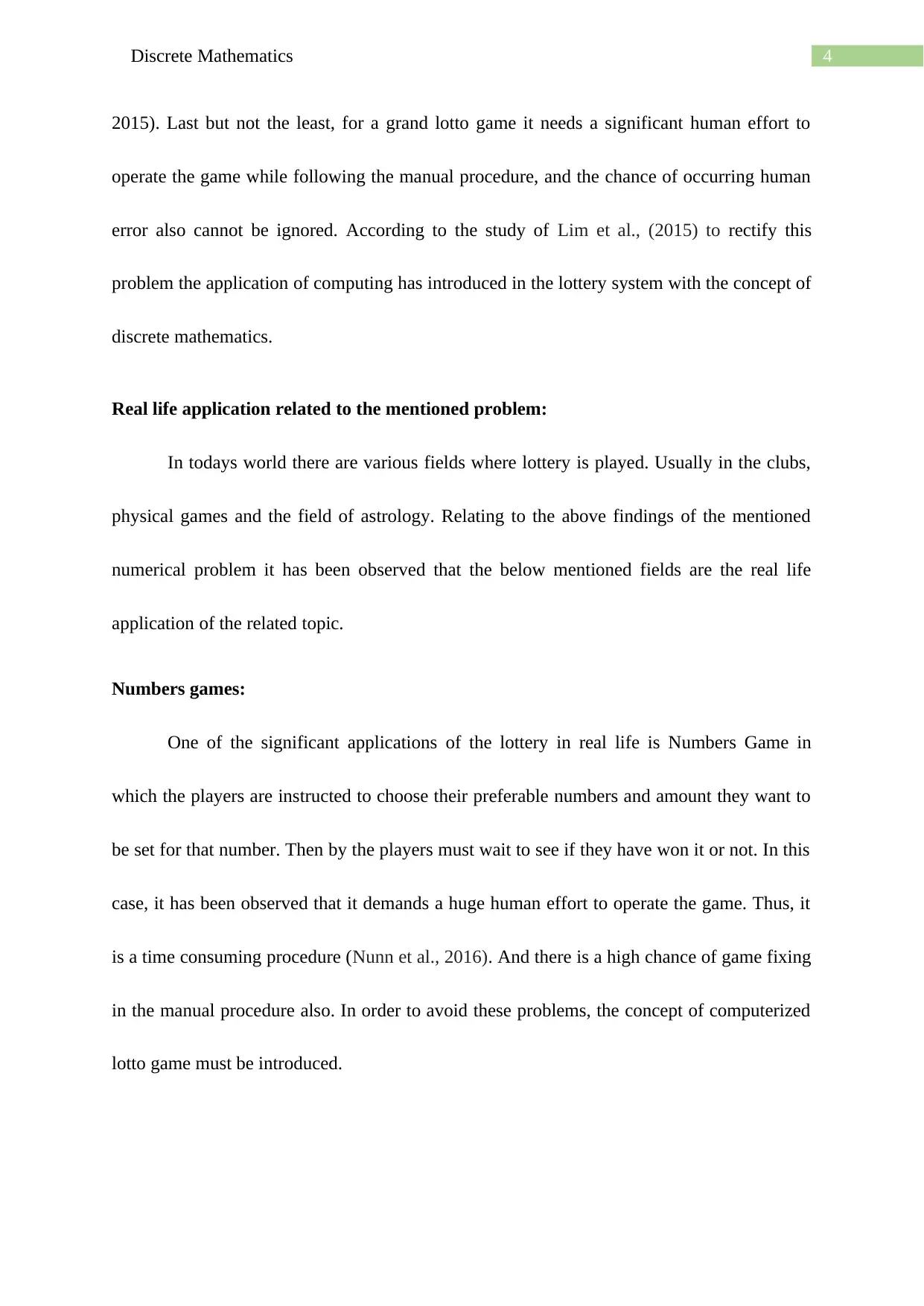
4Discrete Mathematics
2015). Last but not the least, for a grand lotto game it needs a significant human effort to
operate the game while following the manual procedure, and the chance of occurring human
error also cannot be ignored. According to the study of Lim et al., (2015) to rectify this
problem the application of computing has introduced in the lottery system with the concept of
discrete mathematics.
Real life application related to the mentioned problem:
In todays world there are various fields where lottery is played. Usually in the clubs,
physical games and the field of astrology. Relating to the above findings of the mentioned
numerical problem it has been observed that the below mentioned fields are the real life
application of the related topic.
Numbers games:
One of the significant applications of the lottery in real life is Numbers Game in
which the players are instructed to choose their preferable numbers and amount they want to
be set for that number. Then by the players must wait to see if they have won it or not. In this
case, it has been observed that it demands a huge human effort to operate the game. Thus, it
is a time consuming procedure (Nunn et al., 2016). And there is a high chance of game fixing
in the manual procedure also. In order to avoid these problems, the concept of computerized
lotto game must be introduced.
2015). Last but not the least, for a grand lotto game it needs a significant human effort to
operate the game while following the manual procedure, and the chance of occurring human
error also cannot be ignored. According to the study of Lim et al., (2015) to rectify this
problem the application of computing has introduced in the lottery system with the concept of
discrete mathematics.
Real life application related to the mentioned problem:
In todays world there are various fields where lottery is played. Usually in the clubs,
physical games and the field of astrology. Relating to the above findings of the mentioned
numerical problem it has been observed that the below mentioned fields are the real life
application of the related topic.
Numbers games:
One of the significant applications of the lottery in real life is Numbers Game in
which the players are instructed to choose their preferable numbers and amount they want to
be set for that number. Then by the players must wait to see if they have won it or not. In this
case, it has been observed that it demands a huge human effort to operate the game. Thus, it
is a time consuming procedure (Nunn et al., 2016). And there is a high chance of game fixing
in the manual procedure also. In order to avoid these problems, the concept of computerized
lotto game must be introduced.
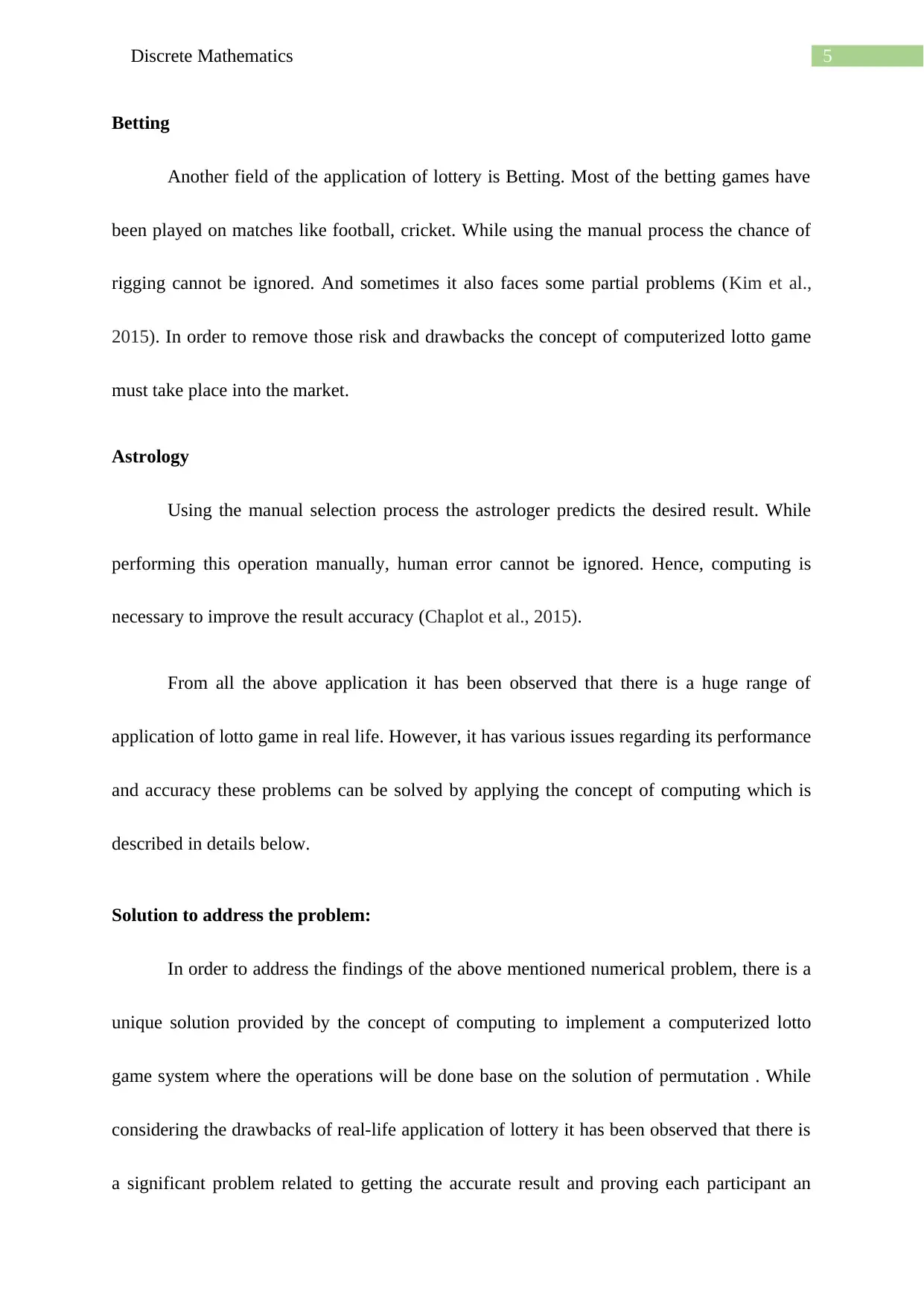
5Discrete Mathematics
Betting
Another field of the application of lottery is Betting. Most of the betting games have
been played on matches like football, cricket. While using the manual process the chance of
rigging cannot be ignored. And sometimes it also faces some partial problems (Kim et al.,
2015). In order to remove those risk and drawbacks the concept of computerized lotto game
must take place into the market.
Astrology
Using the manual selection process the astrologer predicts the desired result. While
performing this operation manually, human error cannot be ignored. Hence, computing is
necessary to improve the result accuracy (Chaplot et al., 2015).
From all the above application it has been observed that there is a huge range of
application of lotto game in real life. However, it has various issues regarding its performance
and accuracy these problems can be solved by applying the concept of computing which is
described in details below.
Solution to address the problem:
In order to address the findings of the above mentioned numerical problem, there is a
unique solution provided by the concept of computing to implement a computerized lotto
game system where the operations will be done base on the solution of permutation . While
considering the drawbacks of real-life application of lottery it has been observed that there is
a significant problem related to getting the accurate result and proving each participant an
Betting
Another field of the application of lottery is Betting. Most of the betting games have
been played on matches like football, cricket. While using the manual process the chance of
rigging cannot be ignored. And sometimes it also faces some partial problems (Kim et al.,
2015). In order to remove those risk and drawbacks the concept of computerized lotto game
must take place into the market.
Astrology
Using the manual selection process the astrologer predicts the desired result. While
performing this operation manually, human error cannot be ignored. Hence, computing is
necessary to improve the result accuracy (Chaplot et al., 2015).
From all the above application it has been observed that there is a huge range of
application of lotto game in real life. However, it has various issues regarding its performance
and accuracy these problems can be solved by applying the concept of computing which is
described in details below.
Solution to address the problem:
In order to address the findings of the above mentioned numerical problem, there is a
unique solution provided by the concept of computing to implement a computerized lotto
game system where the operations will be done base on the solution of permutation . While
considering the drawbacks of real-life application of lottery it has been observed that there is
a significant problem related to getting the accurate result and proving each participant an
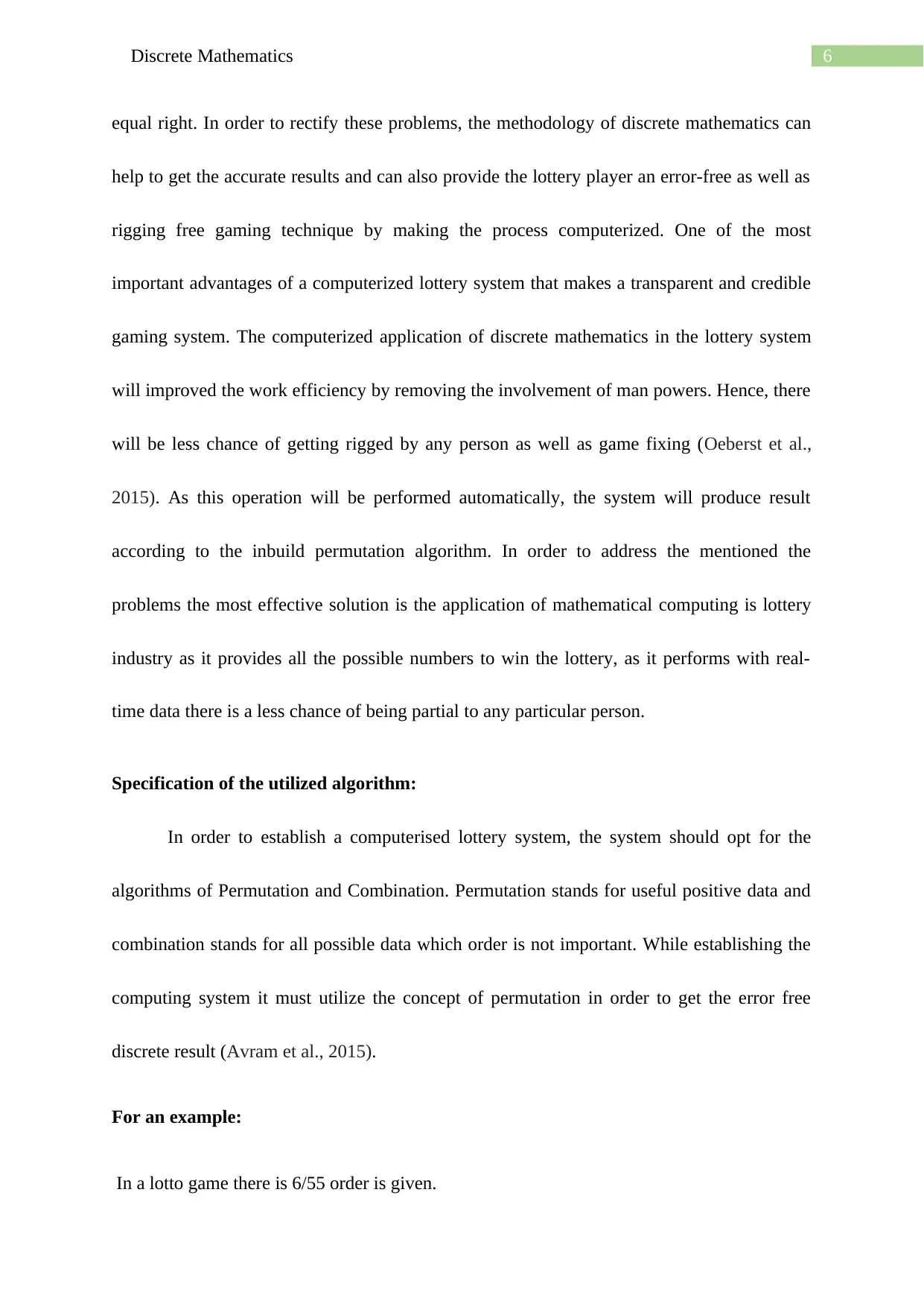
6Discrete Mathematics
equal right. In order to rectify these problems, the methodology of discrete mathematics can
help to get the accurate results and can also provide the lottery player an error-free as well as
rigging free gaming technique by making the process computerized. One of the most
important advantages of a computerized lottery system that makes a transparent and credible
gaming system. The computerized application of discrete mathematics in the lottery system
will improved the work efficiency by removing the involvement of man powers. Hence, there
will be less chance of getting rigged by any person as well as game fixing (Oeberst et al.,
2015). As this operation will be performed automatically, the system will produce result
according to the inbuild permutation algorithm. In order to address the mentioned the
problems the most effective solution is the application of mathematical computing is lottery
industry as it provides all the possible numbers to win the lottery, as it performs with real-
time data there is a less chance of being partial to any particular person.
Specification of the utilized algorithm:
In order to establish a computerised lottery system, the system should opt for the
algorithms of Permutation and Combination. Permutation stands for useful positive data and
combination stands for all possible data which order is not important. While establishing the
computing system it must utilize the concept of permutation in order to get the error free
discrete result (Avram et al., 2015).
For an example:
In a lotto game there is 6/55 order is given.
equal right. In order to rectify these problems, the methodology of discrete mathematics can
help to get the accurate results and can also provide the lottery player an error-free as well as
rigging free gaming technique by making the process computerized. One of the most
important advantages of a computerized lottery system that makes a transparent and credible
gaming system. The computerized application of discrete mathematics in the lottery system
will improved the work efficiency by removing the involvement of man powers. Hence, there
will be less chance of getting rigged by any person as well as game fixing (Oeberst et al.,
2015). As this operation will be performed automatically, the system will produce result
according to the inbuild permutation algorithm. In order to address the mentioned the
problems the most effective solution is the application of mathematical computing is lottery
industry as it provides all the possible numbers to win the lottery, as it performs with real-
time data there is a less chance of being partial to any particular person.
Specification of the utilized algorithm:
In order to establish a computerised lottery system, the system should opt for the
algorithms of Permutation and Combination. Permutation stands for useful positive data and
combination stands for all possible data which order is not important. While establishing the
computing system it must utilize the concept of permutation in order to get the error free
discrete result (Avram et al., 2015).
For an example:
In a lotto game there is 6/55 order is given.
Paraphrase This Document
Need a fresh take? Get an instant paraphrase of this document with our AI Paraphraser
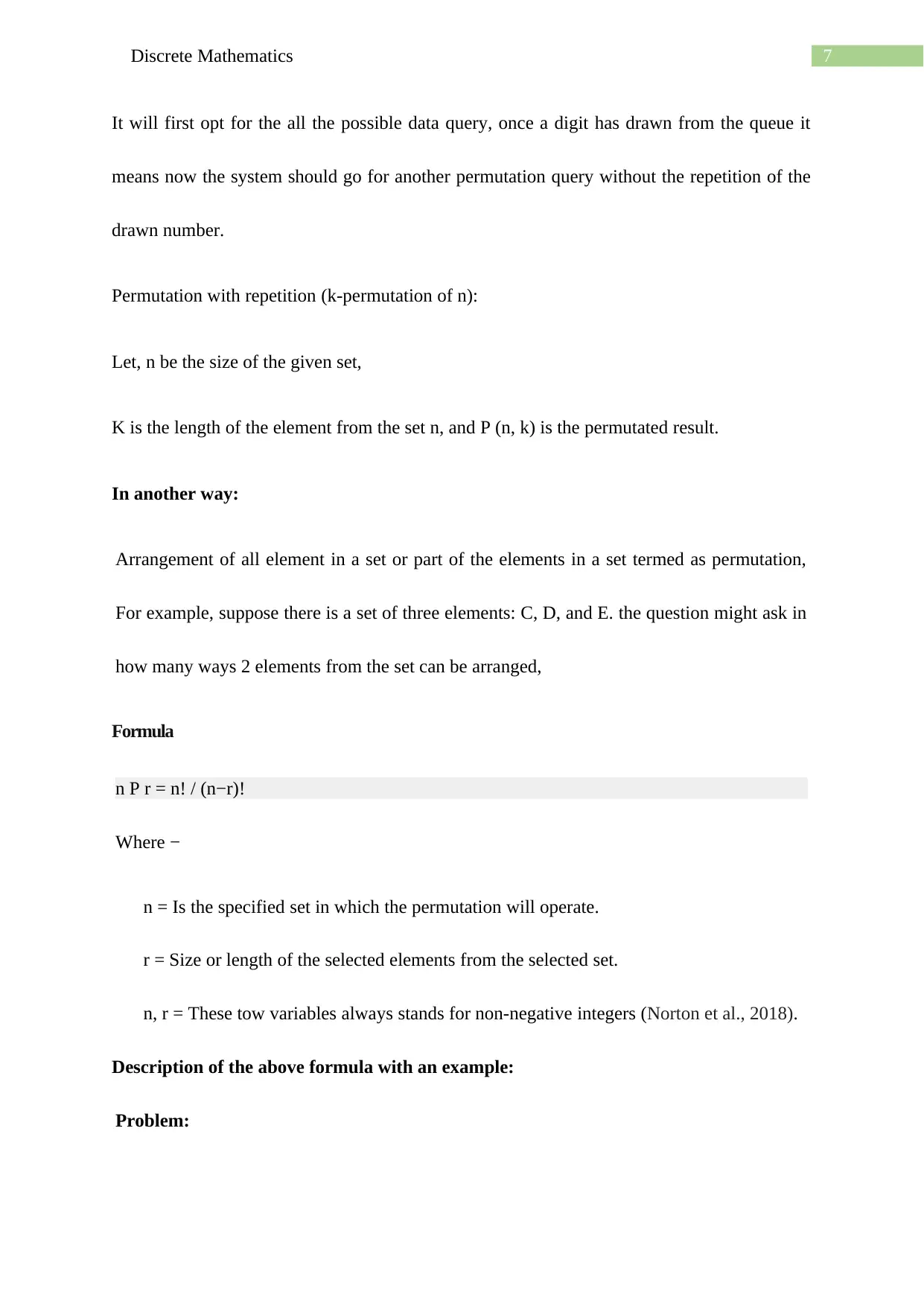
7Discrete Mathematics
It will first opt for the all the possible data query, once a digit has drawn from the queue it
means now the system should go for another permutation query without the repetition of the
drawn number.
Permutation with repetition (k-permutation of n):
Let, n be the size of the given set,
K is the length of the element from the set n, and P (n, k) is the permutated result.
In another way:
Arrangement of all element in a set or part of the elements in a set termed as permutation,
For example, suppose there is a set of three elements: C, D, and E. the question might ask in
how many ways 2 elements from the set can be arranged,
Formula
n P r = n! / (n−r)!
Where −
n = Is the specified set in which the permutation will operate.
r = Size or length of the selected elements from the selected set.
n, r = These tow variables always stands for non-negative integers (Norton et al., 2018).
Description of the above formula with an example:
Problem:
It will first opt for the all the possible data query, once a digit has drawn from the queue it
means now the system should go for another permutation query without the repetition of the
drawn number.
Permutation with repetition (k-permutation of n):
Let, n be the size of the given set,
K is the length of the element from the set n, and P (n, k) is the permutated result.
In another way:
Arrangement of all element in a set or part of the elements in a set termed as permutation,
For example, suppose there is a set of three elements: C, D, and E. the question might ask in
how many ways 2 elements from the set can be arranged,
Formula
n P r = n! / (n−r)!
Where −
n = Is the specified set in which the permutation will operate.
r = Size or length of the selected elements from the selected set.
n, r = These tow variables always stands for non-negative integers (Norton et al., 2018).
Description of the above formula with an example:
Problem:
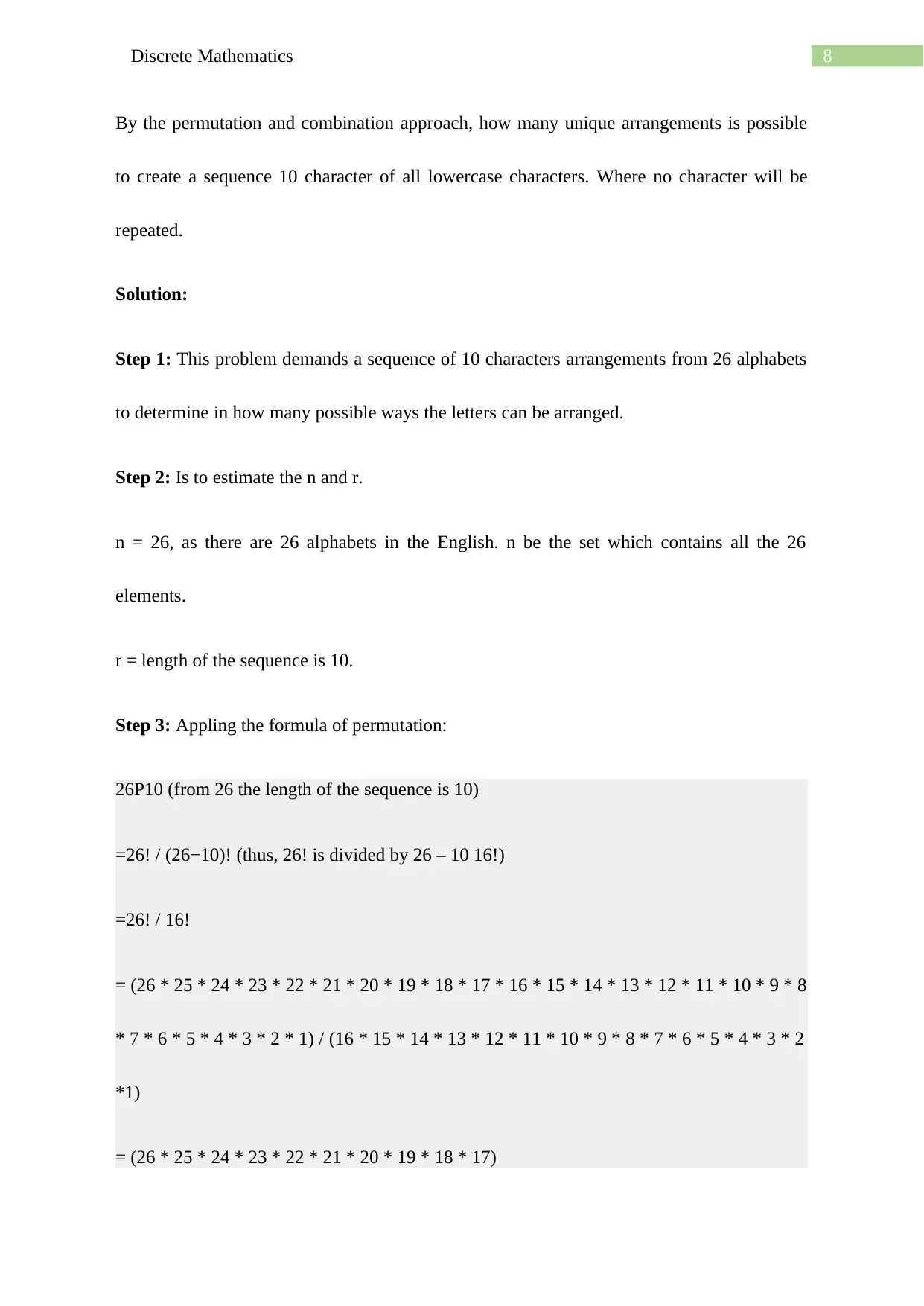
8Discrete Mathematics
By the permutation and combination approach, how many unique arrangements is possible
to create a sequence 10 character of all lowercase characters. Where no character will be
repeated.
Solution:
Step 1: This problem demands a sequence of 10 characters arrangements from 26 alphabets
to determine in how many possible ways the letters can be arranged.
Step 2: Is to estimate the n and r.
n = 26, as there are 26 alphabets in the English. n be the set which contains all the 26
elements.
r = length of the sequence is 10.
Step 3: Appling the formula of permutation:
26P10 (from 26 the length of the sequence is 10)
=26! / (26−10)! (thus, 26! is divided by 26 – 10 16!)
=26! / 16!
= (26 * 25 * 24 * 23 * 22 * 21 * 20 * 19 * 18 * 17 * 16 * 15 * 14 * 13 * 12 * 11 * 10 * 9 * 8
* 7 * 6 * 5 * 4 * 3 * 2 * 1) / (16 * 15 * 14 * 13 * 12 * 11 * 10 * 9 * 8 * 7 * 6 * 5 * 4 * 3 * 2
*1)
= (26 * 25 * 24 * 23 * 22 * 21 * 20 * 19 * 18 * 17)
By the permutation and combination approach, how many unique arrangements is possible
to create a sequence 10 character of all lowercase characters. Where no character will be
repeated.
Solution:
Step 1: This problem demands a sequence of 10 characters arrangements from 26 alphabets
to determine in how many possible ways the letters can be arranged.
Step 2: Is to estimate the n and r.
n = 26, as there are 26 alphabets in the English. n be the set which contains all the 26
elements.
r = length of the sequence is 10.
Step 3: Appling the formula of permutation:
26P10 (from 26 the length of the sequence is 10)
=26! / (26−10)! (thus, 26! is divided by 26 – 10 16!)
=26! / 16!
= (26 * 25 * 24 * 23 * 22 * 21 * 20 * 19 * 18 * 17 * 16 * 15 * 14 * 13 * 12 * 11 * 10 * 9 * 8
* 7 * 6 * 5 * 4 * 3 * 2 * 1) / (16 * 15 * 14 * 13 * 12 * 11 * 10 * 9 * 8 * 7 * 6 * 5 * 4 * 3 * 2
*1)
= (26 * 25 * 24 * 23 * 22 * 21 * 20 * 19 * 18 * 17)
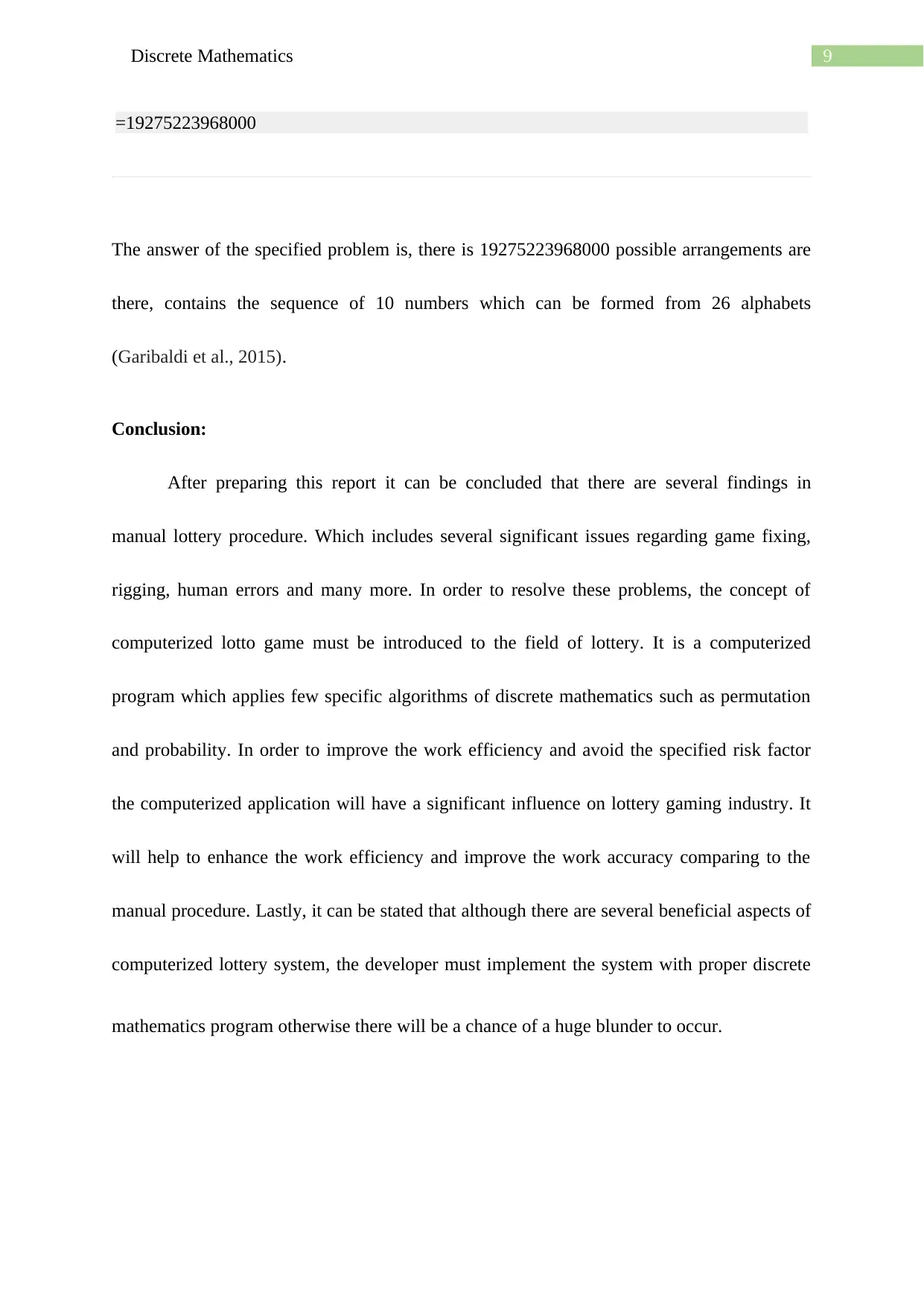
9Discrete Mathematics
=19275223968000
The answer of the specified problem is, there is 19275223968000 possible arrangements are
there, contains the sequence of 10 numbers which can be formed from 26 alphabets
(Garibaldi et al., 2015).
Conclusion:
After preparing this report it can be concluded that there are several findings in
manual lottery procedure. Which includes several significant issues regarding game fixing,
rigging, human errors and many more. In order to resolve these problems, the concept of
computerized lotto game must be introduced to the field of lottery. It is a computerized
program which applies few specific algorithms of discrete mathematics such as permutation
and probability. In order to improve the work efficiency and avoid the specified risk factor
the computerized application will have a significant influence on lottery gaming industry. It
will help to enhance the work efficiency and improve the work accuracy comparing to the
manual procedure. Lastly, it can be stated that although there are several beneficial aspects of
computerized lottery system, the developer must implement the system with proper discrete
mathematics program otherwise there will be a chance of a huge blunder to occur.
=19275223968000
The answer of the specified problem is, there is 19275223968000 possible arrangements are
there, contains the sequence of 10 numbers which can be formed from 26 alphabets
(Garibaldi et al., 2015).
Conclusion:
After preparing this report it can be concluded that there are several findings in
manual lottery procedure. Which includes several significant issues regarding game fixing,
rigging, human errors and many more. In order to resolve these problems, the concept of
computerized lotto game must be introduced to the field of lottery. It is a computerized
program which applies few specific algorithms of discrete mathematics such as permutation
and probability. In order to improve the work efficiency and avoid the specified risk factor
the computerized application will have a significant influence on lottery gaming industry. It
will help to enhance the work efficiency and improve the work accuracy comparing to the
manual procedure. Lastly, it can be stated that although there are several beneficial aspects of
computerized lottery system, the developer must implement the system with proper discrete
mathematics program otherwise there will be a chance of a huge blunder to occur.
Secure Best Marks with AI Grader
Need help grading? Try our AI Grader for instant feedback on your assignments.
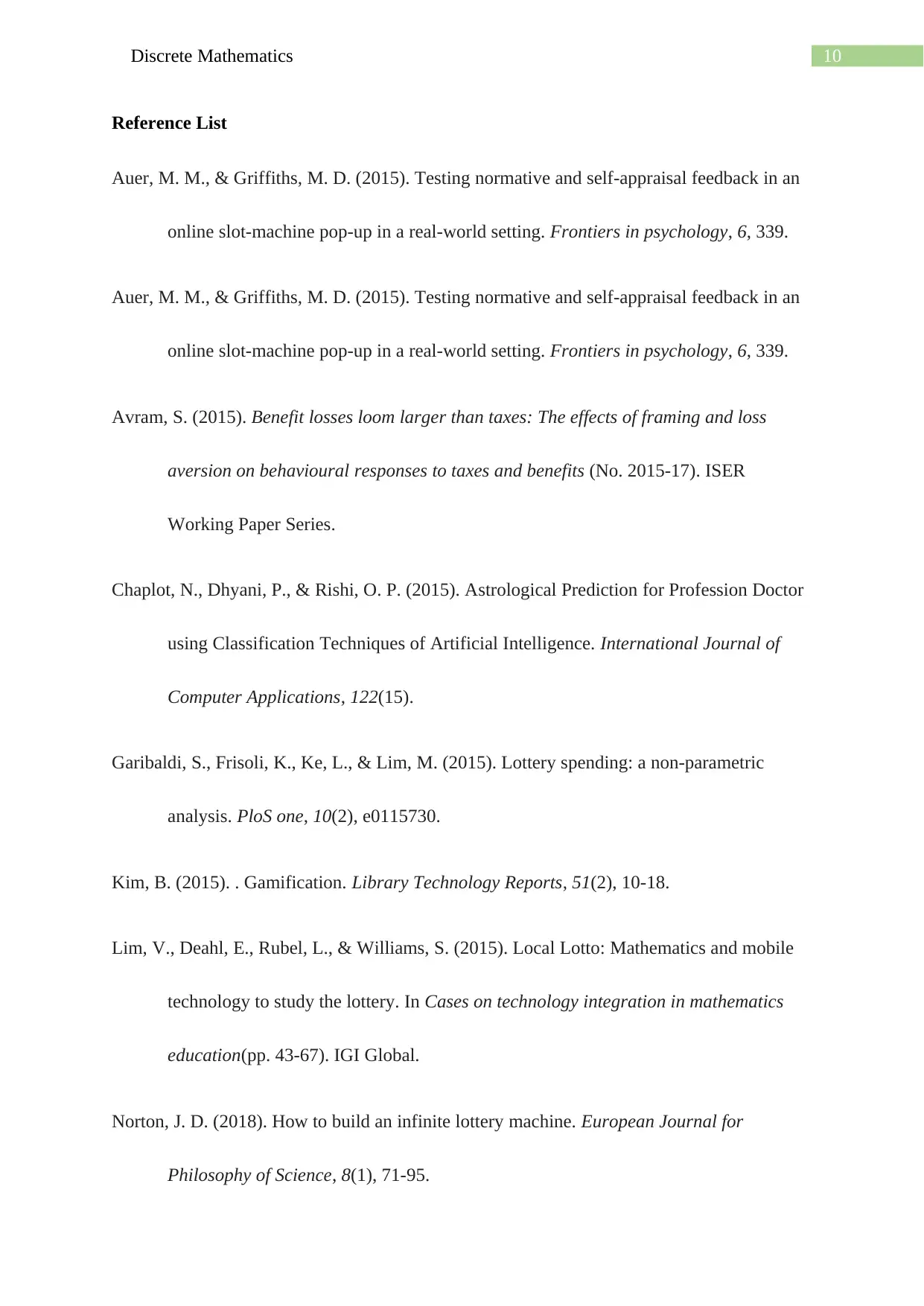
10Discrete Mathematics
Reference List
Auer, M. M., & Griffiths, M. D. (2015). Testing normative and self-appraisal feedback in an
online slot-machine pop-up in a real-world setting. Frontiers in psychology, 6, 339.
Auer, M. M., & Griffiths, M. D. (2015). Testing normative and self-appraisal feedback in an
online slot-machine pop-up in a real-world setting. Frontiers in psychology, 6, 339.
Avram, S. (2015). Benefit losses loom larger than taxes: The effects of framing and loss
aversion on behavioural responses to taxes and benefits (No. 2015-17). ISER
Working Paper Series.
Chaplot, N., Dhyani, P., & Rishi, O. P. (2015). Astrological Prediction for Profession Doctor
using Classification Techniques of Artificial Intelligence. International Journal of
Computer Applications, 122(15).
Garibaldi, S., Frisoli, K., Ke, L., & Lim, M. (2015). Lottery spending: a non-parametric
analysis. PloS one, 10(2), e0115730.
Kim, B. (2015). . Gamification. Library Technology Reports, 51(2), 10-18.
Lim, V., Deahl, E., Rubel, L., & Williams, S. (2015). Local Lotto: Mathematics and mobile
technology to study the lottery. In Cases on technology integration in mathematics
education(pp. 43-67). IGI Global.
Norton, J. D. (2018). How to build an infinite lottery machine. European Journal for
Philosophy of Science, 8(1), 71-95.
Reference List
Auer, M. M., & Griffiths, M. D. (2015). Testing normative and self-appraisal feedback in an
online slot-machine pop-up in a real-world setting. Frontiers in psychology, 6, 339.
Auer, M. M., & Griffiths, M. D. (2015). Testing normative and self-appraisal feedback in an
online slot-machine pop-up in a real-world setting. Frontiers in psychology, 6, 339.
Avram, S. (2015). Benefit losses loom larger than taxes: The effects of framing and loss
aversion on behavioural responses to taxes and benefits (No. 2015-17). ISER
Working Paper Series.
Chaplot, N., Dhyani, P., & Rishi, O. P. (2015). Astrological Prediction for Profession Doctor
using Classification Techniques of Artificial Intelligence. International Journal of
Computer Applications, 122(15).
Garibaldi, S., Frisoli, K., Ke, L., & Lim, M. (2015). Lottery spending: a non-parametric
analysis. PloS one, 10(2), e0115730.
Kim, B. (2015). . Gamification. Library Technology Reports, 51(2), 10-18.
Lim, V., Deahl, E., Rubel, L., & Williams, S. (2015). Local Lotto: Mathematics and mobile
technology to study the lottery. In Cases on technology integration in mathematics
education(pp. 43-67). IGI Global.
Norton, J. D. (2018). How to build an infinite lottery machine. European Journal for
Philosophy of Science, 8(1), 71-95.
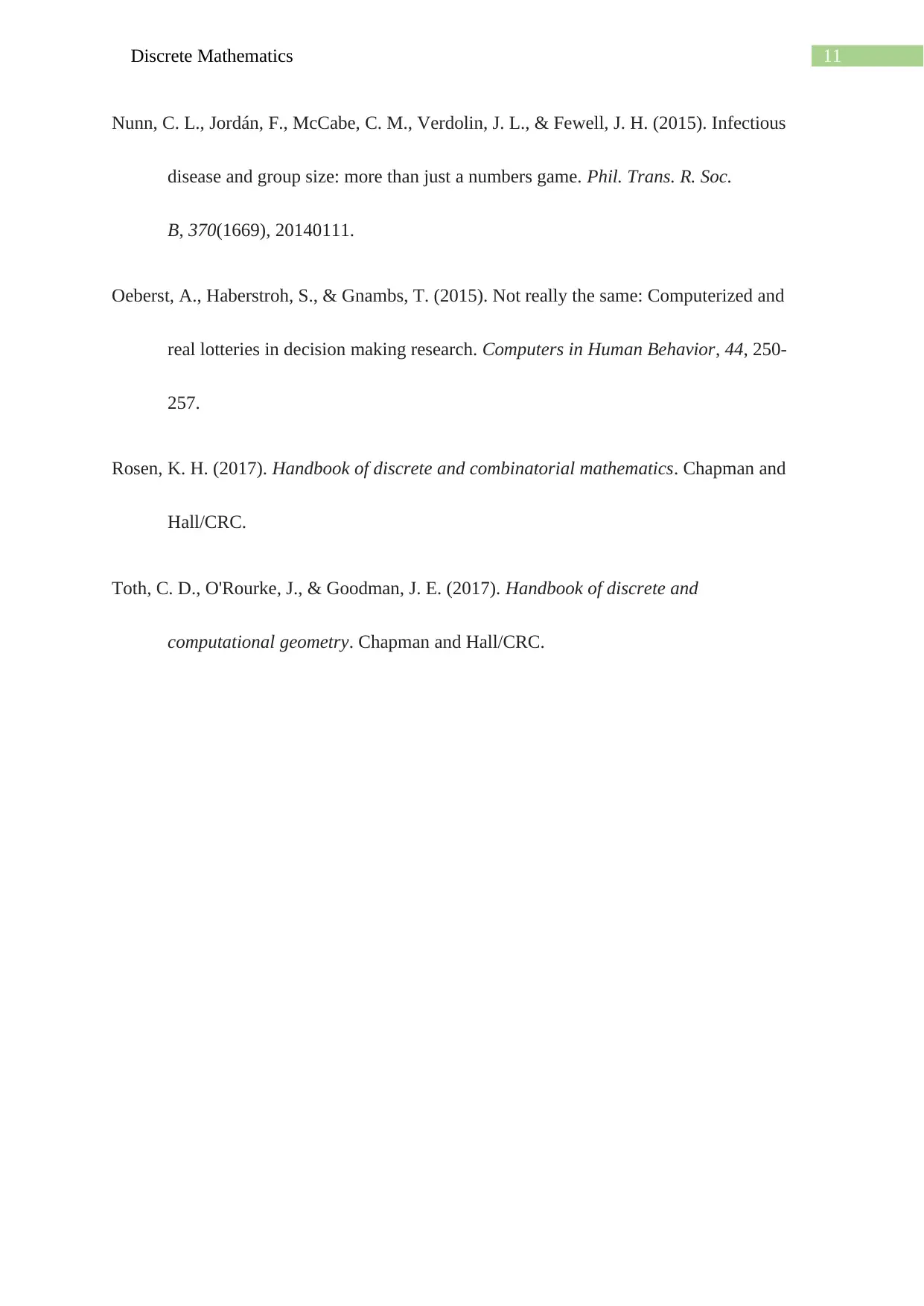
11Discrete Mathematics
Nunn, C. L., Jordán, F., McCabe, C. M., Verdolin, J. L., & Fewell, J. H. (2015). Infectious
disease and group size: more than just a numbers game. Phil. Trans. R. Soc.
B, 370(1669), 20140111.
Oeberst, A., Haberstroh, S., & Gnambs, T. (2015). Not really the same: Computerized and
real lotteries in decision making research. Computers in Human Behavior, 44, 250-
257.
Rosen, K. H. (2017). Handbook of discrete and combinatorial mathematics. Chapman and
Hall/CRC.
Toth, C. D., O'Rourke, J., & Goodman, J. E. (2017). Handbook of discrete and
computational geometry. Chapman and Hall/CRC.
Nunn, C. L., Jordán, F., McCabe, C. M., Verdolin, J. L., & Fewell, J. H. (2015). Infectious
disease and group size: more than just a numbers game. Phil. Trans. R. Soc.
B, 370(1669), 20140111.
Oeberst, A., Haberstroh, S., & Gnambs, T. (2015). Not really the same: Computerized and
real lotteries in decision making research. Computers in Human Behavior, 44, 250-
257.
Rosen, K. H. (2017). Handbook of discrete and combinatorial mathematics. Chapman and
Hall/CRC.
Toth, C. D., O'Rourke, J., & Goodman, J. E. (2017). Handbook of discrete and
computational geometry. Chapman and Hall/CRC.

12Discrete Mathematics
Paraphrase This Document
Need a fresh take? Get an instant paraphrase of this document with our AI Paraphraser

13Discrete Mathematics

14Discrete Mathematics

15Discrete Mathematics
Secure Best Marks with AI Grader
Need help grading? Try our AI Grader for instant feedback on your assignments.

16Discrete Mathematics
1 out of 17
Your All-in-One AI-Powered Toolkit for Academic Success.
+13062052269
info@desklib.com
Available 24*7 on WhatsApp / Email
![[object Object]](/_next/static/media/star-bottom.7253800d.svg)
Unlock your academic potential
© 2024 | Zucol Services PVT LTD | All rights reserved.